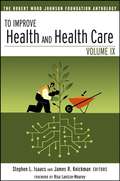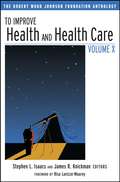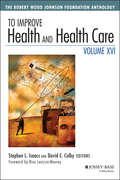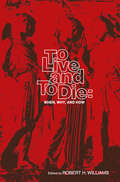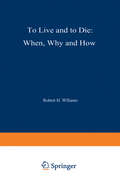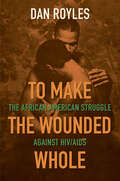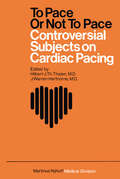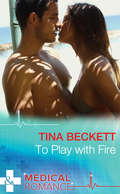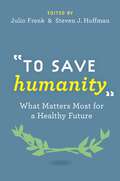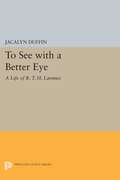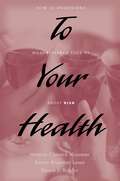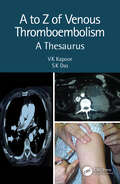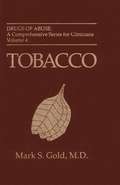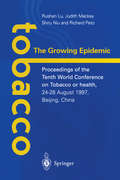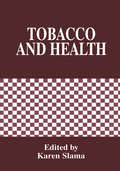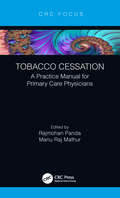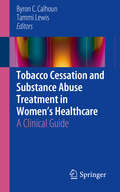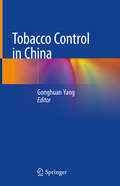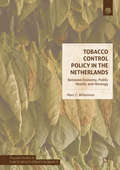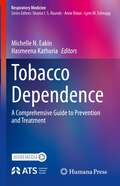- Table View
- List View
To Improve Health and Health Care: The Robert Wood Johnson Foundation Anthology (Public Health/Robert Wood Johnson Foundation Anthology #16)
by Stephen L. Isaacs James R. Knickman Risa Lavizzo-MoureySince 1972, the Robert Wood Johnson Foundation has been the nation's largest philanthropy devoted exclusively to health. To further its mission of improving the health and health care of all Americans, the Foundation strives to foster innovation, develop ideas, disseminate information, and enable committed people to devote their energies to improving the nation's well-being. As part of the Foundation's efforts to inform the public, To Improve Health and Health Care, the ninth volume in the Robert Wood Johnson Foundation Anthology series, provides an in-depth look into the programs it funds. Written for policymakers and practitioners, as well as interested members of the public, the series offers valuable lessons for leaders and educators developing plans for the coming years.
To Improve Health and Health Care Volume X: The Robert Wood Johnson Foundation Anthology (Jossey-Bass Public Health #20)
by Stephen L. Isaacs James R. Knickman Risa Lavizzo-MoureySince 1972, the Robert Wood Johnson Foundation has been the nation's largest philanthropy devoted exclusively to health. To further its mission of improving the health and health care of all Americans, the Foundation strives to foster innovation, develop ideas, disseminate information, and enable committed people to devote their energies to improving the nation's well-being. As part of the Foundation's efforts to inform the public, To Improve Health and Health Care, the tenth volume in the Robert Wood Johnson Foundation Anthology series, provides an in-depth look into the programs it funds. Written for policymakers and practitioners, as well as interested members of the public, the series offers valuable lessons for leaders and educators developing plans for the coming years.
To Improve Health and Health Care, Volume XVI: The Robert Wood Johnson Foundation Anthology (Jossey-Bass Public Health)
by Stephen L. Isaacs David C. ColbyThe RWJF's biannual update on the latest developments in U.S. health care To Improve Health and Health Care is the Robert Wood Johnson Foundation's biannual anthology, focusing on the pressing health and health care issues facing the country. This volume covers some of the most important topics in public health, preventative medicine, and health services. Readers will find an in-depth look into the programs funded by the Robert Wood Johnson Foundation, providing policy makers, practitioners, and interested members of the public a valuable perspective to inform strategy for the coming years. As part of the Foundation's efforts to inform the public, this ongoing anthology of the RWJF provides an update on the latest developments and advances taking place in the field of health, bringing readers up to speed on where we are, and where we still need to go. Understand the new developments in reducing childhood obesity Examine innovations in health care delivery Learn how RWJF programs are making a difference to patients and providers Since 1972, the Robert Wood Johnson Foundation has been the nation's largest philanthropy devoted exclusively to health. To further its mission of improving the health and health care of all Americans, the Foundation strives to foster innovation, develop ideas, disseminate information, and enable committed people to devote their energies to improving the nation's well-being. To Improve Health and Health Care describes the latest outcomes and progress, for a complete overview of the American health care system.
To Improve Health and Health Care, Volume XVI: The Robert Wood Johnson Foundation Anthology (Jossey-Bass Public Health)
by Stephen L. Isaacs David C. ColbyThe RWJF's biannual update on the latest developments in U.S. health care To Improve Health and Health Care is the Robert Wood Johnson Foundation's biannual anthology, focusing on the pressing health and health care issues facing the country. This volume covers some of the most important topics in public health, preventative medicine, and health services. Readers will find an in-depth look into the programs funded by the Robert Wood Johnson Foundation, providing policy makers, practitioners, and interested members of the public a valuable perspective to inform strategy for the coming years. As part of the Foundation's efforts to inform the public, this ongoing anthology of the RWJF provides an update on the latest developments and advances taking place in the field of health, bringing readers up to speed on where we are, and where we still need to go. Understand the new developments in reducing childhood obesity Examine innovations in health care delivery Learn how RWJF programs are making a difference to patients and providers Since 1972, the Robert Wood Johnson Foundation has been the nation's largest philanthropy devoted exclusively to health. To further its mission of improving the health and health care of all Americans, the Foundation strives to foster innovation, develop ideas, disseminate information, and enable committed people to devote their energies to improving the nation's well-being. To Improve Health and Health Care describes the latest outcomes and progress, for a complete overview of the American health care system.
To Live and To Die: When, Why, and How
by Robert H. WilliamsIn the 1960's marked changes occurred throughout the world in philosophies and policies related to man's role in life. These changes, prompted predominantly by extensive increases in knowledge and popula tion density, have produced increased pleasures as well as problems. The rising number of people and improved methods of communication and transportation have caused more relationships among people, with their pleasures, competitions, jealousies, conflicts of interest, oppressions, and crimes. Large assortments of drugs have been developed and are easily obtained. There are drugs to speed us up, slow us down, make us sleep, change our perspectives on life, promote propagation of life or prevent it, prolong life or terminate it, and modify the course of life in many ways. Also, numerous mechanical devices have been developed that influence the propagation of life, the termination of life, and the manner in which we live. Many people have changed their overall goals in life, and in par ticular have experienced major changes in attitudes and policies applying to sexual activity, marriage, birth control, abortion, welfare, children, old people, criminals, economics, social status, careers, education, euthanasia, and suicide. There also has been marked enlightenment concerning the effect of the chemical and physical status of the brain upon normal and abnormal thinking and behavior.
To Live and to Die: When, Why, and How
by Robert H. WilliamsIn the 1960's marked changes occurred throughout the world in philosophies and policies related to man's role in life. These changes, prompted predominantly by extensive increases in knowledge and popula tion density, have produced increased pleasures as well as problems. The rising number of people and improved methods of communication and transportation have caused more relationships among people, with their pleasures, competitions, jealousies, conflicts of interest, oppressions, and crimes. Large assortments of drugs have been developed and are easily obtained. There are drugs to speed us up, slow us down, make us sleep, change our perspectives on life, promote propagation of life or prevent it, prolong life or terminate it, and modify the course of life in many ways. Also, numerous mechanical devices have been developed that influence the propagation of life, the termination of life, and the manner in which we live. Many people have changed their overall goals in life, and in par ticular have experienced major changes in attitudes and policies applying to sexual activity, marriage, birth control, abortion, welfare, children, old people, criminals, economics, social status, careers, education, euthanasia, and suicide. There also has been marked enlightenment concerning the effect of the chemical and physical status of the brain upon normal and abnormal thinking and behavior.
To Make the Wounded Whole: The African American Struggle against HIV/AIDS (Justice, Power, and Politics)
by Dan RoylesIn the decades since it was identified in 1981, HIV/AIDS has devastated African American communities. Members of those communities mobilized to fight the epidemic and its consequences from the beginning of the AIDS activist movement. They struggled not only to overcome the stigma and denial surrounding a "white gay disease" in Black America, but also to bring resources to struggling communities that were often dismissed as too "hard to reach." To Make the Wounded Whole offers the first history of African American AIDS activism in all of its depth and breadth. Dan Royles introduces a diverse constellation of activists, including medical professionals, Black gay intellectuals, church pastors, Nation of Islam leaders, recovering drug users, and Black feminists who pursued a wide array of grassroots approaches to slow the epidemic's spread and address its impacts. Through interlinked stories from Philadelphia and Atlanta to South Africa and back again, Royles documents the diverse, creative, and global work of African American activists in the decades-long battle against HIV/AIDS.
To Pace or not to Pace: Controversial Subjects in Cardiac Pacing
by Hilbert J. Th. Thalen J. W. HarthorneThe increasing number of pacemaker patients correlates with the number of pacemaker meetings that attract physicians and medical engineers entering this expanding branch of medicine. The Pacemaker Colloquium organised in Brussels April 21st and 22nd 1977 was such a meeting. It was different from previous meetings as it had no surveys or summaries on patient series but instead it focused on controversial subjects that have emerged from pacing in the past and on new developments for the future. Besides controversial papers on indications for temporary and long-term pacing, new technical developments were presented in Brussels, where for the first time the important lithium battery manufacturers demonstrated their data. The surveys on electrodes, especially the fixation mechanisms and the atrial electrodes, initiated an animated discussion. This all converged in a Round Table on the choice of the electrode-pacemaker combination. Pacemaker electrocar diography and the application of cardiac stimulation in various types oftachyar rhythmias formed two clinically oriented sessions. Mter a survey ofthe various follow-up systems a series of presentations deals for the first time with the possibilities and difficulties of the application of com puters in cardiac pacing. A Round Table on the organisation of the Pacemaker clinic closed this friendly and animated meeting. It is our sincere hope that the publication of the presented papers and dis cussions in these Proceedings will help all those active in cardiac pacing to answer some of their problems and to improve the treatment of pacemaker patients.
To Play With Fire: Master Of Her Innocence / To Play With Fire / A Taste Of Desire (Hot Brazilian Docs! #1)
by Tina BeckettMarcos Pinheiro shouldn’t be thinking about colleague Maggie. But her innocent fire has him reliving their one wild, shameless night… Maggie’s heart has been buried for so long – only in Marcos’s arms has she ever felt free from her past demons. But is Marcos’s passion enough to banish the shadows for ever?
To Save Humanity: What Matters Most for a Healthy Future
by Julio Frenk Steven Hoffman"The UN was not created to take mankind to heaven, but to save humanity from hell." --Dag Hammarskjöld, United Nations Secretary-General 1953-1961 The turn of the 21st century was an objective low point in the history of human health: AIDS was scourging Africa, millions of women died each year in child birth, and billions suffered under malnourishment and poverty. In response, the United Nations launched its Millennium Development Goals (MDGs), an ambitious charter that since 2000 has measurably reduced the worldwide burdens of poverty, hunger, and disease. With the MDGs set to expire in 2015, continued progress on these fronts is anything but certain. In addition to the persisting threats of the 20th century, globalization has sped the development of new threats--pandemics, climate change, chronic disease--that now threaten rich and poor countries equally. "To Save Humanity" is a collection of short, honest essays on what single issue matters most for the future of global health. Authored by the world's leading voices from science, politics, and social advocacy, this collection is both a primer on the major issues of our time and a potential blueprint for post-2015 health and development. This unparalleled collection will provide illuminating and thought-provoking reading for anyone invested in our collective future and well-being.
To Save Humanity: What Matters Most for a Healthy Future
by Steven Hoffman Julio Frenk"The UN was not created to take mankind to heaven, but to save humanity from hell." --Dag Hammarskjöld, United Nations Secretary-General 1953-1961 The turn of the 21st century was an objective low point in the history of human health: AIDS was scourging Africa, millions of women died each year in child birth, and billions suffered under malnourishment and poverty. In response, the United Nations launched its Millennium Development Goals (MDGs), an ambitious charter that since 2000 has measurably reduced the worldwide burdens of poverty, hunger, and disease. With the MDGs set to expire in 2015, continued progress on these fronts is anything but certain. In addition to the persisting threats of the 20th century, globalization has sped the development of new threats--pandemics, climate change, chronic disease--that now threaten rich and poor countries equally. "To Save Humanity" is a collection of short, honest essays on what single issue matters most for the future of global health. Authored by the world's leading voices from science, politics, and social advocacy, this collection is both a primer on the major issues of our time and a potential blueprint for post-2015 health and development. This unparalleled collection will provide illuminating and thought-provoking reading for anyone invested in our collective future and well-being.
To See with a Better Eye: A Life of R. T. H. Laennec
by Jacalyn DuffinRené Théophile Hyacinthe Laennec (1781-1826) is best known for his invention of the stethoscope, one of medicine's most powerful symbols. Histories, novels, and films have cloaked his life in hagiography and legend. Jacalyn Duffin's fascinating new biography relies on a vastly expanded foundation of primary source material, including thousands of pages of handwritten patient records, lecture notes, unpublished essays, and letters. She situates Laennec, the scientist and teacher, within the broader social and intellectual currents of post-Revolutionary France. Her work uncovers a complex character who participated actively in the dramatic changes of his time.Laennec's famous Treatise on Mediate Auscultation was his only published book, but two lesser known works were left in manuscript: an early treatise on pathological anatomy and a later set of lectures on disease. The three parts of Duffin's biography correspond to these books. First, she examines Laennec's student research on the emerging science of pathological anatomy, the background for his major achievement. Second, she uses his clinical records to trace the discovery and development of "mediate auscultation" (listening through an instrument, or mediator, to sounds within the human body). The stethoscope allowed clinicians to "see" the organic alterations inside their living patients' bodies. Finally, she explores the impact of auscultation on diagnostic practice and on concepts of disease. Analyzed here for the first time in their entirety, Laennec's Collége de France lectures reveal his criticism of over-enthusiastic extrapolations of his own method at the expense of the patient's story.Originally published in 1998.The Princeton Legacy Library uses the latest print-on-demand technology to again make available previously out-of-print books from the distinguished backlist of Princeton University Press. These editions preserve the original texts of these important books while presenting them in durable paperback and hardcover editions. The goal of the Princeton Legacy Library is to vastly increase access to the rich scholarly heritage found in the thousands of books published by Princeton University Press since its founding in 1905.
To Your Health: How to Understand What Research Tells Us about Risk
by Helena Chmura Kraemer Karen Kraemer Lowe, David J. KupferThe public is bombarded daily with reports about risk factors, many conflicting with each other, others accepted as "scientific truth" for awhile, then scientifically disproved, yet others questionable that later prove to be true. Physicians are faced with trying to make sense of those conflicting or questionable results in the scientific literature in order to guide their patients to the best possible decisions. The situation is not much easier for scientists who may waste years of their productive life, and considerable resources, basing their research efforts on what prove to be misleading earlier research findings. What this book does is to present, in non "academese" and with many examples from the general media and scientific journals, a guide to a critical reading of research reports, which, in turn, serves as a guide to researchers as to which approaches are likely to be regarded with raised eyebrows, and what they need to do to generate results that will be taken seriously. This stimulating and helpful book was written for informed consumers and physicians as well as for scientists evaluating the risk research literature or contemplating projects on risk research.
A to Z of Venous Thromboembolism: A Thesaurus
by VK Kapoor SK DasVenous thrombo-embolism, venous thrombosis and pulmonary embolism are common complications in postoperative patients. This focused handbook covers the topics of epidemiology, screening, and prophylaxis along with diagnosis and management of venous thrombo-embolism. It covers both mechanical and pharmacological methods of prophylaxis and various drugs used in prevention and treatment viz. heparins (unfractionated and low molecular weight), anticoagulants (vitamin K antagonists and novel oral anticoagulants), etc. The A-Z format makes this book a useful practical guide. The approach will break the barriers to the use of venous thrombo-embolism prophylaxis in the minds of physicians. Key Features Discusses the content in an innovative A-Z format Contains practical tips for day-to-day clinical management Examines the use of venous thrombo-embolism prophylaxis by practicing physicians and residents
A to Z of Venous Thromboembolism: A Thesaurus
by VK Kapoor SK DasVenous thrombo-embolism, venous thrombosis and pulmonary embolism are common complications in postoperative patients. This focused handbook covers the topics of epidemiology, screening, and prophylaxis along with diagnosis and management of venous thrombo-embolism. It covers both mechanical and pharmacological methods of prophylaxis and various drugs used in prevention and treatment viz. heparins (unfractionated and low molecular weight), anticoagulants (vitamin K antagonists and novel oral anticoagulants), etc. The A-Z format makes this book a useful practical guide. The approach will break the barriers to the use of venous thrombo-embolism prophylaxis in the minds of physicians. Key Features Discusses the content in an innovative A-Z format Contains practical tips for day-to-day clinical management Examines the use of venous thrombo-embolism prophylaxis by practicing physicians and residents
The to Z of You and Me
by James HannahAN OBSERVER 'NEW FACE OF FICTION 2015'AN AMAZON RISING STAR 2015'Genuinely one of the best books I've read ever read' LISA JEWELL'Spare, poignant and with a quirky charm all of its own, it reminds us how kind people can be.' RACHEL JOYCE'Absolutely bloody heartrending. Hannah's eccentric style is never mawkish and often wonderfully funny' - THE TIMES'Hannah writes with emotional acuity. Warm, wry, thoughtful and devastating in places, this is a life-enhancing missive from death's door' - THE SUNDAY TIMESA striking literary debut of love and mortality perfect for fans of quirky, heart-wrenching fiction like Nathan Filer, David Nicholls and Rachel Joyce.Ivo has all kinds of everyday joy in his life – he’s young, he's in love, he has friends who promise to stand by him if life ever goes wrong.Then one day, life does go wrong. He makes a mistake, and it’s big and unforgiveable. Now time is running out and his life is falling apart. But he’s going to put it together again. His own way.This is a story about how far love must stretch to gather a life in pieces. And how strong friendship never dies.
Tobacco (Drugs of Abuse: A Comprehensive Series for Clinicians #4)
by Mark S. GoldAuthor Mark S. Gold presents the latest medical information on nicotine and tobacco's neurobiological, physiological, and psychological effects. This timely monograph also discusses the latest diagnostic and treatment programs as well as model programs for use by practitioners which were developed by the National Cancer Institute and other eminent organizations. The author also includes a comprehensive history of tobacco use.
Tobacco: Proceedings of the Tenth World Conference on Tobacco or Health, 24–28 August 1997, Beijing, China
by Rushan Lu Judith Mackay Shiru Niu Richard PetoThis book contains the full proceedings of the Tenth World Conference on Tobacco or Health, held 24-28 August 1997 in Beijing, China, and hosted by the Chinese Association on Smoking and Health and the Chinese Medical Association.Tobacco is now causing a worldwide epidemic of premature death and disability, affecting first men and then women in developed countries, and now increasingly affecting developing countries. The theme "Tobacco: The Growing Epidemic" was chosen to reflect the increasingly global nature of the problem.
Tobacco Cessation: A Practice Manual for Primary Care Physicians
by Rajmohan Panda Manu Raj MathurCessation of tobacco use is the need of the hour given that it is the single largest cause of disease and premature death in the world. This book covers epidemiology and risks, user classification, nicotine replacement therapy, pharmacological aids, behavioral modification and patient counseling techniques, along with personalized action plan development. Key Features Covers all aspect of tobacco cessation. Provides guidance on differential diagnosis and includes useful decision-making flowcharts. Provides step-by-step guidance to counsel tobacco users in routine clinical practice. Discusses the process of setting up a cessation centre. Facilitates in-depth understanding of the subject through case studies at the end of each chapter
Tobacco Cessation: A Practice Manual for Primary Care Physicians
by Rajmohan Panda Manu Raj MathurCessation of tobacco use is the need of the hour given that it is the single largest cause of disease and premature death in the world. This book covers epidemiology and risks, user classification, nicotine replacement therapy, pharmacological aids, behavioral modification and patient counseling techniques, along with personalized action plan development. Key Features Covers all aspect of tobacco cessation. Provides guidance on differential diagnosis and includes useful decision-making flowcharts. Provides step-by-step guidance to counsel tobacco users in routine clinical practice. Discusses the process of setting up a cessation centre. Facilitates in-depth understanding of the subject through case studies at the end of each chapter
Tobacco Cessation and Substance Abuse Treatment in Women’s Healthcare: A Clinical Guide
by Byron C. Calhoun Tammi LewisThis book is a comprehensive guide to the screening, management, and treatment of female patients with addictions. There are a range of clinical issues specific to women with substance use disorders and substance abuse during pregnancy is known to have deleterious effects on neonates. This book focuses on the effective care of the addicted patient and discusses novel outpatient therapy, therapeutic substitution, abstinence therapy, and the importance of counseling in the delivery of care. Topics include the physiology of nicotine, opiates, EtOH, and other substances of abuse; the role of receptors and neurotransmitters in addiction; the effects of tobacco and substance abuse on women’ s health; and tobacco cessation methods. Featuring practical approaches to gender-responsive treatment, Tobacco Cessation and Substance Abuse in Women’s Healthcare is a valuable resource for obstetricians, gynecologists, family medicine practitioners, and residents hoping to expand their knowledge of tobacco cessation and substance abuse in women’s health.
Tobacco Control in China
by Gonghuan YangThis book comprehensively covers the science and policy issues relevant to one of the major public health issues in China. It pulls together the prevalence pattern of tobacco use in different population and burden of the myriad of tobacco-related diseases. The book pays more attention to review the successes and failures of tobacco control policies in China, including the protect peoples from second-hand smoke, comprehensive banning tobacco advertisement promotion and sponsor, regulation of the contents of tobacco products and low tar cigarettes, warn about the dangers of tobacco, support for smokers to quit, and increasing tobacco taxation and price, as well as monitor and assessment on tobacco use and implement of prevention policy under the international background of tobacco control.The book analyse and explain the influence factors, especially interference from tobacco industry with public management theory frame for promoting tobacco control policies and looks at lessons learnt to help set health policy for reducing the burden of tobacco-related diseases. It is a helpful reference for experts in public health and epidemiologists in tobacco control, advocators and policy maker.
Tobacco Control Policy in the Netherlands: Between Economy, Public Health, and Ideology (Palgrave Studies in Public Health Policy Research)
by Marc C. WillemsenGovernments have known since the 1960s that smoking results in irreversible health damage. This open access book examines why governments have done so little to combat this when they have been aware of the problem and its solutions for decades. What are the strategies and decisions that make a difference, given that policy environments are often not conducive to change? Taking the Netherlands as an example, this book helps to understand the complex policy process at the national level and why it so often appears irrational to us. It is the most sophisticated analysis of tobacco control policy to date, applying insights from political sciences to the field of tobacco control.
Tobacco Dependence: A Comprehensive Guide to Prevention and Treatment (Respiratory Medicine)
by Michelle N. Eakin Hasmeena KathuriaThis book is a guide to pharmacotherapy treatment of tobacco dependence. The 2020 American Thoracic Society clinical practice guidelines on treating tobacco dependence serves as the cornerstone for this work with its robust discussion of recommended treatment options and how to tailor treatment to specific patient populations. Tobacco dependence remains a major health concern for many adults and given the dramatic increase of youth electronic cigarette use, clinicians need a singular resource to treat these different populations. This book addresses that by following the three main points of how to best address the adverse impact of tobacco use on public health: 1) prevent initiation of tobacco use; 2) understand mechanisms of addiction; 3) effectively treat tobacco dependence.The book begins by describing the current patterns of product use, the adverse impact of tobacco on global health, and tobacco-related health disparities. Authors discuss both combustible and electronic tobacco products, as well as current research on the adverse impact of vaping and associated flavorings including menthol, role of the e-cigarette in cessation, and treatment of adolescent nicotine dependence. Chapters conclude with a discussion of specific tobacco control policies to improve overall public health. This is an ideal guide for pulmonologists, pediatricians, primary care physicians and other specialty providers who see patients with nicotine dependence. This book is also of interest to public health professions to help inform public health campaigns and treatment offerings to reduce overall tobacco product use through prevention and treatment.
